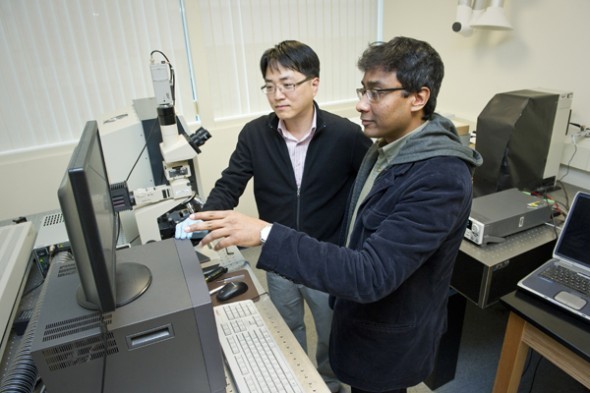
Every second, your computer must process billions of computational steps to produce even the simplest outputs. Imagine if every one of those steps could be made just a tiny bit more efficient. "It would save precious nanoseconds," explained Northeastern University assistant professor of physics Swastik Kar.
 Kar and his colleague Yung Joon Jung, an associate professor in the Department of Mechanical and Industrial Engineering, have developed a series of novel devices that do just that. Their work was published Sunday in the journal Nature Photonics.
Kar and his colleague Yung Joon Jung, an associate professor in the Department of Mechanical and Industrial Engineering, have developed a series of novel devices that do just that. Their work was published Sunday in the journal Nature Photonics.
Last year, the interdisciplinary duo combined their expertise -- Kar's in graphene, a carbon-based material known for its strength and conductivity, and Jung's in the mechanics of carbon nanotubes, which are nanometer-sized rolled up sheets of graphene -- to unearth a physical phenomenon that could usher in a new wave of highly efficient electronics.
They discovered that light-induced electrical currents rise much more sharply at the intersection of carbon nanotubes and silicon, compared to the intersection of silicon and a metal, as in traditional photodiode devices. "That sharp rise helps us design devices that can be turned on and off using light," Kar said.
This finding has major implications for performing computations, which, in simple terms, also rely on a series of on-off switches. But in order to access the valuable information that can be stored on these switches, it must also be transferred to and processed by other switches. "People believe that the best computer would be one in which the processing is done using electrical signals and the signal transfer is done by optics," Kar said.
This isn't too surprising since light is extremely fast. Kar and Jung's devices -- which are the first to integrate electronic and optical properties on a single electronic chip -- represent a critical breakthrough in making this dream computer a reality.
The computational modeling of these junctions were performed in close collaboration with the group of Young-Kyun Kwon, a professor at Kyung Hee University, in Seoul, Korea.
In the new paper, the team presents three such new devices. The first is a so-called AND-gate, which requires both an electronic and an optical input to generate an output. This switch only triggers if both elements are engaged.
The second device, an OR-gate, can generate an output if either of two optical sensors is engaged. This same configuration can also be used to convert digital signals into analog ones, an important capability for actions such as turning the digital content of an MP3 file into actual music.
Finally, Kar and Jung also built a device that works like the front-end of a camera sensor. It consists of 250,000 miniature devices assembled over a centimeter-by-centimeter surface. While this device would require more integration to be fully viable, it allowed the team to test the reproducibility of their assembly process.
"Jung's method is a world-class technique," Kar said. "It has really enabled us to design a lot of devices that are much more scalable."

 Previous page
Previous page Back to top
Back to top







